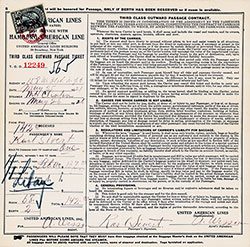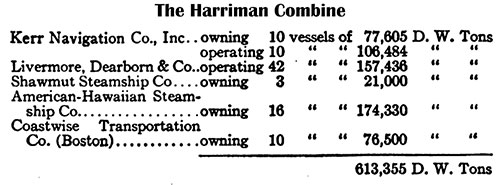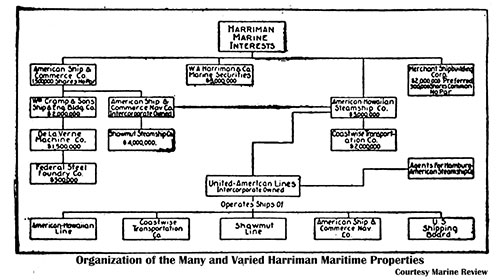United American Lines (Harriman Line): The Rise and Fall of America’s Transatlantic Steamship Ambitions (1920–1926)
W. Averell Harriman founded the United American Lines, American Shipping and Commercial Corporation, in 1920. Harriman entered into agreements with the Hamburg-America Line (HAPAG) to handle transatlantic passenger traffic between Hamburg, Southampton, Cherbourg, and New York. The Steamship line was sold to HAPAG in 1926.
Explore the history of United American Lines, the ambitious American shipping company founded by W. Averell Harriman in 1920. Discover passenger lists, corporate strategies, and maritime controversies that shaped transatlantic travel before its 1926 sale to Hamburg-America Line. A must-read for genealogists, historians, and ocean liner enthusiasts.
Quick Links To Topics Covered
1. Passenger Lists
(C) Cleveland (R1) Reliance (R2) Resolute
2. Passage Contracts, Tickets, and Receipts
3. Menus
4. The Resolute-Reliance Transfer
6. Bibliography
7. Recap and Summary of the United American Lines (Harriman Line) Archival Collection
1. Passenger Lists

1923-10-21 SS Cleveland Passenger List
- Steamship Line: United American Lines (Harriman Line)
- Class of Passengers: Cabin Class
- Date of Departure: 21 October 1923
- Route: Hamburg to New York via Southampton
- Commander: Captain W. P. Hillman

1925-05-08 SS Cleveland Passenger List
- Steamship Line: United American Lines (Harriman Line)
- Class of Passengers: Cabin Class
- Date of Departure: 8 May 1925
- Route: Hamburg to New York via Boulogne and Southampton
- Commander: Captain W. P. Hillman

1922-11-15 SS Reliance Passenger List
- Steamship Line: United American Lines (Harriman Line)
- Class of Passengers: First and Second Class
- Date of Departure: 15 November 1922
- Route: Hamburg to New York via Southampton and Cherbourg
- Commander: Captain F. L. Iverson

1923-07-10 SS Reliance Passenger List
- Steamship Line: United American Lines (Harriman Line)
- Class of Passengers: First and Second Class
- Date of Departure: 10 July 1923
- Route: Hamburg to New York via Southampton and Cherbourg
- Commander: Captain F. L. Iverson

1925-07-14 SS Reliance Passenger List
- Steamship Line: United American Lines (Harriman Line)
- Class of Passengers: First and Second Class
- Date of Departure: 14 July 1925
- Route: New York to Hamburg via Cherbourg and Southampton
- Commander: Captain F. L. Iverson.

1922-09-05 SS Resolute Passenger List
- Steamship Line: United American Lines (Harriman Line)
- Class of Passengers: First and Second Class
- Date of Departure: 5 September 1922
- Route: Hamburg to New York via Southampton and Cherbourg
- Commander: Captain D. Malman

1923-07-24 SS Resolute Passenger List
- Steamship Line: United American Lines (Harriman Line)
- Class of Passengers: First and Second Class
- Date of Departure: 24 July 1923
- Route: Hamburg for New York via Southampton and Cherbourg
- Commander: Commodore D. Malman

1925-05-19 SS Resolute Passenger List
- Steamship Line: United American Lines (Harriman Line)
- Class of Passengers: First and Second Class
- Date of Departure: 19 May 1925
- Route: Hamburg to New York via Southampton and Cherbourg
- Commander: Commodore D. Malman

1925-06-30 SS Resolute Passenger List
- Steamship Line: United American Lines (Harriman Line)
- Class of Passengers: First and Second Class
- Date of Departure: 30 June 1925
- Route: New York to Hamburg via Cherbourg and Southampton
- Commander: Commodore D. Malman

1925-09-08 SS Resolute Passenger List
- Steamship Line: United American Lines (Harriman Line)
- Class of Passengers: First and Second Class
- Date of Departure: 8 September 1925
- Route: Hamburg for New York via Southampton and Cherbourg
- Commander: Captain W. P. Hillman
2. Passage Contracts, Tickets, and Receipts

SS Mount Clinton Passage Contract - 26 May 1921
Rare Outward Bound (eastward) Passenger Steamship Ticket for Third Class accommodations on the SS Mount Clinton of the United American Lines on her maiden voyage to Hamburg, Germany.
3. Menus

1922-08-24 SS Resolute Luncheon Menu
Vintage Luncheon Menu from 24 August 1922 on board the SS Resolute of the United American Lines featured Roast Chicken Fermière, Lobster Newbourg, and Wine Jelly with Fruits for dessert.

1925-05-20 SS Resolute Luncheon Menu Card
Cabin passenger Luncheon Menu from the S.S. Resolute of the United American Lines included both hot and cold selections. it featured Boiled Brisket of Beef, Vienna Veal Steak and the perennial favorite Frankfurters with Sauerkraut. Printed in English and German,
4. The Resolute-Reliance Transfer
The transfer of the steamships Resolute and Reliance to the Panama flag is doubly regretted. The American merchant marine not only loses two large passenger vessels but may suffer more severely, if indirectly, through the use that may be made of the incident by opponents of a subsidy.
In fairness to the Shipping Board, however, it should be said that it had no power to prevent a transfer since the vessels were transferred from the Dutch to the American flag under an agreement that re-transfer would be permitted within three years. A statement issued by R. H. M. Robinson outlines the reasons that actuated the Atlantic Mail Corporation (United American Lines) to change to the Panama registry.
We deeply regret that circumstances have arisen, compelling us to operate the Resolute and Reliance under a foreign flag. This is a situation we would have preferred to avoid.
Early last summer, we arranged to charter the Resolute to Raymond & Whitcomb Company for a global cruise and the Reliance for a cruise to the West Indies and South America. However, the publication of the attorney general's opinion on applying the Federal prohibition law to American ships on the high seas led to the cancellation of more than fifty passages on the Resolute alone, particularly the more expensive accommodations.
Because of the keen competition of cruises arranged for foreign steamers, the cruises of the Resolute and Reliance cannot be carried out successfully unless the passengers are offered the same service and privileges as on foreign ships. Therefore, given the large sums involved, and in fairness to our stockholders, we have completed arrangements to transfer the vessel to a foreign flag. We have selected the Panama flag because it is the most acceptable to the interests of the United States.
After their cruises, the Resolute and Reliance will resume sailings between New York and Europe, a testament to our commitment to maintaining these crucial routes. As in the past, these sailings will be operated by the United American Lines in joint service with the Hamburg-American Line. This joint service arrangement ensures that the ships will continue to provide the same level of service and quality that passengers have come to expect.
5. The Harriman Combine
Another prominent American steamship combine is that group around the person of W. A. Harriman, son of the famous railroad magnate. The combination is sometimes referred to as the American Ship and Commerce Corporation, sometimes as the United American Lines, Incorporated. Previous to the latest reorganization, the chief holdings [1] in shipping concerns were as follows:

Chief Holdings in Shipping Concerns Pertaining to The Harriman Combine. Ocean Shipping, 1923. GGA Image ID # 21fea08dcc
The method of control is both complicated and interesting; interesting because it reflects the diversity of the various incorporating laws of different States and is a typical example of how a corporate organization strives to reap the benefit of the most favorable features of the various State laws. The following is a statement of the relationship between the multiple companies supplied to the writer by one of the officers of the American Ship and Commerce Corporation:
American Ship and Commerce Corporation is a holding company organized under the laws of the State of Delaware. It owns only the majority shares of American Ship and Commerce Navigation Corporation—organized under the laws of the State of New York, formerly known as the Kerr Navigation Corporation—and the majority shares of the Wm. Cramp & Sons Shipbuilding and Engine Works; also the majority shares of the Shawmut Steamship Company, a Boston corporation.
Grouped with these companies—but with no direct financial affiliations—is the American Hawaiian Steamship Company, which in turn owns the majority shares of the Coastwise Steamship Company.
The operating activities of all these owning steamship companies are centered in the United American Lines, Incorporated, which is purely an operating company and does not own a single steamer. The stock of United
American Lines, Incorporated, is held jointly, in equal parts, by the American Ship and Commerce Corporation’s subsidiary, American Ship & Commerce Navigation Corporation, and American Hawaiian Steamship Company.
In addition to acting as operating agent for the above-named steamship companies, United American Lines, Incorporated acts as the United States Shipping Board operator for steamers traveling from New York to the Near East, Java, and the Straits Settlement.
“The Harriman shipbuilding corporation, known as Merchants Shipbuilding Corporation, with plants at Bristol and Chester, Pennsylvania, is not in any way affiliated with the United American Lines, Incorporated, because United American Lines, Incorporated is not a ship-owning or shipbuilding company but a ship-operating company.” 2
The following organization chart gives a clear conception of a complex matter :
Organization of the Many and Varied Harriman Marine Properties. Courtesy of the Marine Review. Ocean Shipping, 1923. GGA Image ID # 21feddeeb2. Click to View a Larger Image.
The American Ship and Commerce Corporation's operating agreement with the Hamburg-American Line, which has the crucial support of the Shipping Board, has attracted significant attention. Under this agreement, United American Lines, Incorporated will operate ships—partly ex-German Liners—over the trade routes previously served by the German line. The corporation will use the equipment and organization the Germans had acquired and developed before the war. A less extensive contract exists between the United States Mail Steamship Company and the North German Lloyd of Bremen.
End Notes
- Nautical Gazette, June 12, 1920, p. 879, and August 14, 1920, p. 197.
- Since this was written the Harriman Marine Interests have furthermore branched out into the export coal business with the formation of Warren Export Coal Company in January, 1921.
6. Bibliography
"The Resolute-Reliance Transfer," in Pacific Marine Review: The Nautical Magazine of Shipping, San Francisco: Vol. 19, No. 12, December 1922, p. 659
"Chapter XXIII: Concentration and Combination: The Harriman Combine" in Erich W. Zimmermann, Zimmermann on Ocean Shipping, New York: Prentice-Hall, Inc., 1923, p. 444-447
7. Recap and Summary of the United American Lines (Harriman Line) Archival Collection
The United American Lines (U.A.L.), founded by W. Averell Harriman in 1920, played a pivotal role in transatlantic passenger travel during the early 20th century. This shipping enterprise was short-lived but highly influential, acting as an American competitor to well-established European liners. Operating in partnership with the Hamburg-America Line (HAPAG), U.A.L. transported thousands of immigrants, business travelers, and tourists between Hamburg, Southampton, Cherbourg, and New York before being sold to HAPAG in 1926.
This archival collection is an essential resource for teachers, students, genealogists, and maritime historians, offering valuable insights into U.S. and European migration, business collaborations in the shipping industry, and corporate struggles in early 20th-century ocean travel.
Most Interesting Highlights & Key Content
1. Passenger Lists: Tracing Migration & Travel (1922–1925)
The passenger lists from U.A.L. voyages provide important genealogical records for those tracing European immigrants, American travelers, and maritime personnel.
Passenger lists from ships such as SS Cleveland, SS Reliance, and SS Resolute document journeys between Hamburg and New York, frequently stopping in Southampton and Cherbourg.
These records are particularly valuable for genealogists researching ancestral migration from Germany and Eastern Europe to the United States.
Example Passenger Lists Include:
- 1923-10-21 SS Cleveland (Hamburg to New York via Southampton)
- 1922-11-15 SS Reliance (Hamburg to New York via Southampton & Cherbourg)
- 1925-06-30 SS Resolute (New York to Hamburg via Cherbourg & Southampton)
These documents serve as crucial resources for historians and genealogists, allowing them to trace family histories, migration trends, and passenger demographics.
2. Passage Contracts & Tickets: The Business of Ocean Travel (1921)
A notable document in this collection is the 1921 SS Mount Clinton Passage Contract, which represents a rare outward-bound voyage from New York to Libau (Liepāja, Latvia) via Hamburg.
The contract is significant as it highlights reverse migration from the U.S. back to Europe, possibly due to economic instability, political changes, or failed immigration attempts.
This section is particularly insightful for researchers studying the effects of post-World War I displacement, refugee movements, and early American immigration policies.
3. Menus & Shipboard Life: A Glimpse into Ocean Travel (1922–1925)
The menus aboard U.A.L. ships provide a fascinating look into shipboard life, showcasing the luxury and culinary diversity aboard these ocean liners.
- The 1922-08-24 SS Resolute Luncheon Menu featured Roast Chicken Fermière, Lobster Newbourg, and Wine Jelly with Fruits—demonstrating high-end European dining standards.
- The 1925-05-20 SS Resolute Luncheon Menu included Vienna Veal Steak and Frankfurters with Sauerkraut, highlighting Germanic culinary influences.
These menus illustrate the contrast between first-class and steerage meals, providing a cultural and social lens into passenger experiences aboard early 20th-century transatlantic voyages.
This section is particularly interesting for food historians, maritime researchers, and genealogists seeking insights into their ancestors' voyage conditions.
4. The Resolute-Reliance Transfer: American Ships Under Foreign Flags (1922)
This section highlights a major controversy in U.S. maritime history—the transfer of SS Resolute and SS Reliance to the Panama flag.
Due to the strict enforcement of Prohibition laws on American ships, U.A.L. saw a sharp decline in luxury cruise bookings, leading to the cancellation of major global and Caribbean cruises.
To compete with European cruise liners, U.A.L. transferred the ships to Panama’s registry, which allowed alcohol sales onboard, thereby retaining their market.
The Resolute and Reliance continued operations under the Hamburg-America Line, reinforcing the competitive challenges faced by American liners against European dominance.
This section is valuable for historians studying the impact of U.S. Prohibition on global commerce, maritime law, and American corporate strategies.
5. The Harriman Combine: Corporate Power in Shipping (1920s)
This section details the complex corporate structure behind U.A.L., led by W. Averell Harriman, a powerful railroad magnate who sought to build a dominant American shipping empire.
The Harriman Combine was a network of interlinked companies—including United American Lines, American Ship & Commerce Corporation, and Hamburg-America Line.
The Harriman group attempted to compete with European shipping giants, but American maritime laws and financial difficulties forced its sale to HAPAG in 1926.
The corporate structure chart included in the collection offers a rare look at the financial and legal complexities of international shipping conglomerates.
This section is highly relevant for business historians and scholars analyzing global trade, corporate mergers, and the economic forces shaping early 20th-century shipping.
Why This Collection is Valuable
This archival collection is an essential resource for multiple audiences, offering deep historical insights into transatlantic travel, corporate shipping strategies, and maritime business operations.
- Teachers & Students: This collection provides real-world examples of migration, trade, and international business practices, making it a valuable teaching resource for maritime and economic history courses.
- Genealogists: The passenger lists and passage contracts allow genealogists to trace their ancestors' immigration paths, ticket purchases, and shipboard experiences.
- Historians: The U.A.L. story illustrates the challenges of American shipping, corporate expansion, and economic policies in the early 20th century.
- Maritime Enthusiasts: The detailed fleet information, corporate charts, and ocean liner menus offer an inside look into ocean travel during the 1920s.

